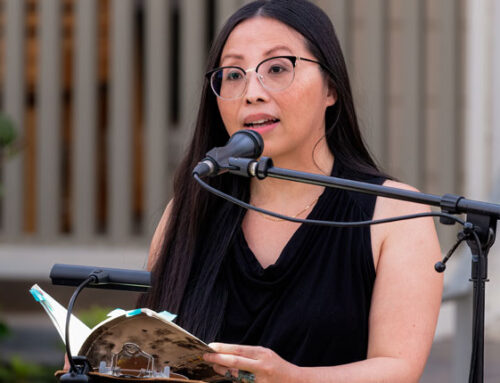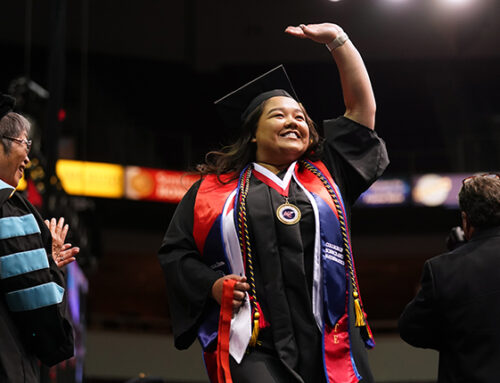Fresno State forensic science graduate student Michael Gonzalez, shown with mentor Dr. Kevin Miller, won the 2010 Wildlife Forensic Science Award from the Society for Wildlife Forensic Sciences (SWFS) for outstanding thesis work that has been recognized by the FBI. On the screen is a strand of zebra hair.
Michael Gonzalez, a forensic science student at California State University, Fresno, has received the 2010 Wildlife Forensic Science award from the Society for Wildlife Forensic Sciences (SWFS) for outstanding thesis work that has been recognized by the FBI.
Gonzalez developed a computerized hair database that can be used by practitioners around the world to analyze class characteristics in hundreds of different species of mammals, including the world’s most endangered and highly trafficked.
A second-year graduate student from Diamond Bar, Gonzalez is enrolled in the Professional Science Master’s Degree Program in the Chemistry Department of the College of Science and Mathematics and is the program’s first Hispanic student.
Created in September 2008, Gonzalez’ Internet-based database will ultimately hold more than 2,000 mammalian species and has already become well known in the professional forensic world including the prestigious National Institute of Justice and the Federal Bureau of Investigation, reports Dr. Kevin Miller, assistant professor of chemistry and criminology at Fresno State and director of the Forensic Science master’s program. He is Gonzalez’ faculty mentor.
Under Miller’s direction, Gonzalez began creating and compiling the database from hair specimens found in the collection of Fresno State’s Biology Department. This work quickly spread to include eight different body regions of each animal and is being conducted in collaboration with the U.S. Fish and Game Wildlife Forensic Laboratory in Ashland, Oregon.
Gonzalez will receive cash and an invitation to present his work at the inaugural meeting of the SWFS in Oregon in April.
The results of Gonzalez’ pilot work were presented last summer at the Trace Evidence Symposium in Florida, which was co-sponsored by the National Institute of Justice and the FBI. The symposium is an international forum for forensic professionals to learn from each other and present new ways to analyze forensic trace evidence recovered from crime scenes.
Dr. Edward Espinoza, deputy director of the National Fish and Wildlife Forensic Laboratory, said Gonzalez’ computerized online database “will provide a valuable digital resource for researchers and forensic investigators.”
Miller elaborated on the database’s significance.
“Animal poaching is a multi-billion dollar industry, second only to narcotic trafficking,” Miller said. “The endangered species represented in this database help laboratory personnel who do not have large reference collections of their own to identify key structural features of the hairs they are likely to encounter.”
The database also is a valuable resource for smaller forensic laboratories, Miller added, such as local labs in the Central Valley that may not have dedicated trace evidence examiners on staff.
“These smaller local labs can use the data base as a reference for non-human hairs that they are likely to be asked to identify from the scenes of violent crimes,” he said.
The Professional Science Master’s Degree Program in Forensic Science started in 2006 and now has nine students enrolled. Gonzalez’ research is conducted through the Forensic Biotechnology Institute of California, a nonprofit ancillary unit of Fresno State established through the College of Science and Mathematics.
The institute, which furthers teaching and research in biological science and technology with a particular emphasis on forensics, provides technical leadership to the law enforcement and criminal justice communities by applying advancements in biotechnology to the law.




